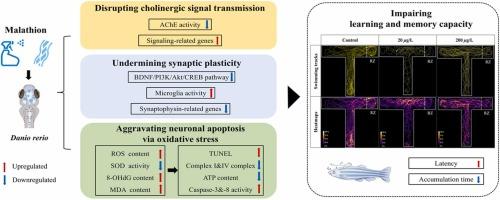马拉硫磷通过破坏胆碱能信号传递、破坏突触可塑性和加重神经元凋亡,损害斑马鱼的学习和记忆能力
IF 11.3
1区 环境科学与生态学
Q1 ENGINEERING, ENVIRONMENTAL
引用次数: 0
摘要
马拉硫磷等有机磷农药在水环境中的普遍存在对水生生物构成严重威胁。虽然大脑是马拉硫磷的潜在目标,但对其对鱼类认知功能的影响知之甚少。在这项研究中,我们评估了马拉硫磷暴露4周对斑马鱼使用t -迷宫任务学习和记忆的影响。除了验证马拉硫磷在脑内的蓄积及其对血脑屏障完整性的有害影响外,还确定了马拉硫磷对胆碱能信号传递、突触可塑性、细胞凋亡和氧化应激的影响。我们的研究结果表明,4周的马拉硫磷暴露会导致典型的学习和记忆缺陷行为。除抑制胆碱能信号传递外,马拉硫磷还严重破坏突触可塑性(表现为BDNF/PI3K/AKT/CREB通路被破坏,突触素被抑制,小胶质细胞被激活)。此外,在暴露于马拉硫磷的斑马鱼的大脑中检测到明显更高水平的TUNEL荧光信号以及可能由氧化应激诱导的凋亡酶和基因。综上所述,我们的研究结果表明,环境现实水平的马拉硫磷会通过诱导氧化应激,破坏胆碱能信号传递,损害突触可塑性,加剧神经元凋亡,从而显著破坏斑马鱼的学习和记忆。本文章由计算机程序翻译,如有差异,请以英文原文为准。

Exposure to malathion impairs learning and memory of zebrafish by disrupting cholinergic signal transmission, undermining synaptic plasticity, and aggravating neuronal apoptosis
The prevalence of organophosphorus pesticides, such as malathion, in water environments poses a severe threat to aquatic organisms. Although the brain is a potential target for malathion, little is known about its effect on cognitive functions in fish. In this study, we evaluated the effect of 4-week malathion exposure on the learning and memory of zebrafish using T-maze tasks. In addition to verifying the accumulation of malathion in the brain and its deleterious effects on blood-brain barrier integrity, the impacts of malathion on cholinergic signal transmission, synaptic plasticity, apoptosis, and oxidative stress were determined. Our results demonstrated that a 4-week malathion exposure resulted in typical learning and memory-deficit-like behaviors. Apart from inhibiting cholinergic signal transmission, synaptic plasticity was severely undermined by malathion (as evidenced by the disruption of BDNF/PI3K/AKT/CREB pathway, suppression of synaptophysins, and activation of microglia). Moreover, significantly higher levels of TUNEL fluorescence signals as well as apoptotic enzymes and genes probably induced by oxidative stress were detected in the brains of malathion-exposed zebrafish. Collectively, our results suggested that malathion at environmentally realistic levels can significantly undermine learning and memory of zebrafish by disrupting cholinergic signal transmission, impairing synaptic plasticity, and aggravating neuronal apoptosis via inducing oxidative stress.
求助全文
通过发布文献求助,成功后即可免费获取论文全文。
去求助
来源期刊

Journal of Hazardous Materials
工程技术-工程:环境
CiteScore
25.40
自引率
5.90%
发文量
3059
审稿时长
58 days
期刊介绍:
The Journal of Hazardous Materials serves as a global platform for promoting cutting-edge research in the field of Environmental Science and Engineering. Our publication features a wide range of articles, including full-length research papers, review articles, and perspectives, with the aim of enhancing our understanding of the dangers and risks associated with various materials concerning public health and the environment. It is important to note that the term "environmental contaminants" refers specifically to substances that pose hazardous effects through contamination, while excluding those that do not have such impacts on the environment or human health. Moreover, we emphasize the distinction between wastes and hazardous materials in order to provide further clarity on the scope of the journal. We have a keen interest in exploring specific compounds and microbial agents that have adverse effects on the environment.
 求助内容:
求助内容: 应助结果提醒方式:
应助结果提醒方式:


